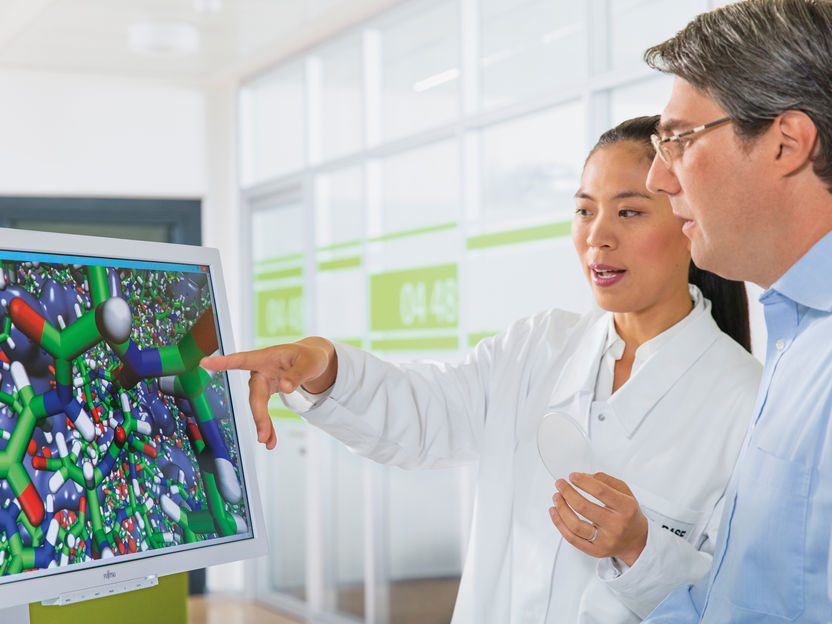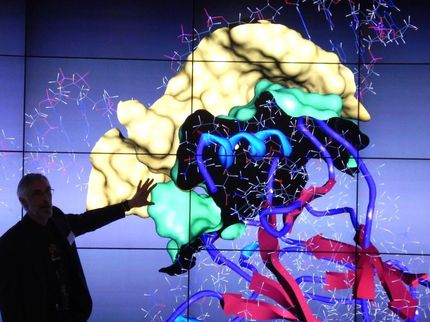BASF pushes digitalization in research worldwide
Chemical industry’s largest supercomputer creates new opportunities for researchers to carry out complex modeling
BASF’s strategic goal is to decisively take advantage of the enormous opportunities that digitalization offers along the entire value chain. In doing so, research and development play a key role when it comes to further increasing innovative strength and competitiveness by using new technologies. At its Research Press Conference today in Ludwigshafen, the company provides insight into the digitalization of chemical research as well as its tools and applications.

Digitalization in research contributes to making research work more efficient, expanding knowledge networks, and creating more space for creativity. Chemist Dr. Fangfang Chu and simulation expert Dr. Eduard Schreiner discuss the computer simulation of a microencapsulation. It is used to protect active ingredients, for example from moisture, and at the same time ensures that they are released in the right place at the right time. Simulations help to better understand and predict the complex chemical and physical interactions within the microcapsule, allowing laboratory test series to be planned more precisely.
BASF SE
“With the increased use of digital technologies in research and development, we are strengthening BASF’s position as the world’s most innovative company in the chemical industry,” said Dr. Martin Brudermüller, Vice Chairman of the Board of Executive Directors and Chief Technology Officer of BASF SE. In particular, the new supercomputer will enable BASF experts to very efficiently investigate complex questions and it will further shorten the time it takes to launch new products, according to Brudermüller. “We will thus be even better able to meet our customers’ demands for tailor-made innovations based on chemistry.”
At the press conference, experts from various fields of application will speak about how digitalization in R&D works in practice. A key element is the new supercomputer which will be put into operation this summer in Ludwigshafen. With 1.75 petaflops, it offers around 10 times the computing power that BASF currently has dedicated to scientific computing. In the ranking of the 500 largest computing systems in the world, the BASF supercomputer is currently number 65. In an online contest, employees enthusiastically voted to name the supercomputer “Quriosity,” which aptly describes its enormous potential to break new ground in product development.
Virtual and real-life experiments complement each other
Digital technologies have a rapidly expanding influence on research and development. Managing large quantities of data has become a decisive factor for future scientific and economic success. With BASF’s digital approach, virtual modeling and computer simulation go hand in hand with physical experiments in the lab – they complement each other. Simulations help with the design of experiments and facilitate forecasting, while experiments deliver measurable results and evaluate the computer models. This results in a better understanding of chemical products and processes, and thus enables greater innovation to be achieved in a shorter period of time.
Digitalization gives researchers additional opportunities to implement their creative ideas and to collaborate intensively with others around the world. In the view of BASF experts, it is essential to integrate digital technologies directly into the daily work of the R&D units. Direct access to knowledge-based systems is necessary to enable effective problem-solving and it opens up new horizons. A cloud-based app platform, for example, will make it considerably easier for all researchers to expand knowledge networks.
In recent months, successful projects by BASF researchers have already demonstrated the enormous potential that digitalization offers in research. For example, researchers were able for the first time to conduct a systematic investigation of the data on catalysts used in the production of the intermediate product ethylene oxide. The investigation found correlations between the formulations and the application properties of the catalysts, which enabled their performance and lifetime to be predicted more accurately and faster.
Targeted searching through large volumes of data
Digital technologies also played a vital role in the modeling of a new functional polymer for the stable formulation of an active ingredient. From more than 10,000 possibilities, BASF experts were able to work out the appropriate polymer structure. The subsequent synthesis resulted in the desired formulation polymer, which enabled the creation of a significantly more concentrated emulsion. Modeling like this has now become an established component of the development of formulations.
With “data mining,” it is possible to extract useful knowledge from very large quantities of existing data. When it comes to product or process development in the field of biotechnology, for instance, this can include the accelerated identification of promising enzymes or the discovery of suitable bacteria.
Agronomic models support farmers
BASF is also playing an important role in the digital transformation of agriculture, where it relies on internal and external cooperation. The online application Maglis® helps farmers use available information more efficiently and make better decisions regarding the cultivation of their fields. The firm ZedX, which BASF acquired at the end of May, specializes in developing agronomic models for weather, plant growth and infestation with diseases, weeds and pests. BASF and ZedX have already jointly developed a model that, based on weather and environmental conditions, identifies the right window of application for a BASF herbicide.
R&D figures illustrate high level of commitment
BASF aims to maintain its research and development expenditures at the high level of previous years. In 2016, R&D spending amounted to €1,863 million, slightly below the previous year’s level (€1,953 million) due to structural adjustments in the plant biotechnology activities. BASF’s research pipeline included around 3,000 projects in 2016, which are being worked on by around 10,000 employees in R&D worldwide. One crucial pillar of the Know-How Verbund remains the global network of cooperative partnerships in many different disciplines with around 600 universities, research institutes and companies.




















































